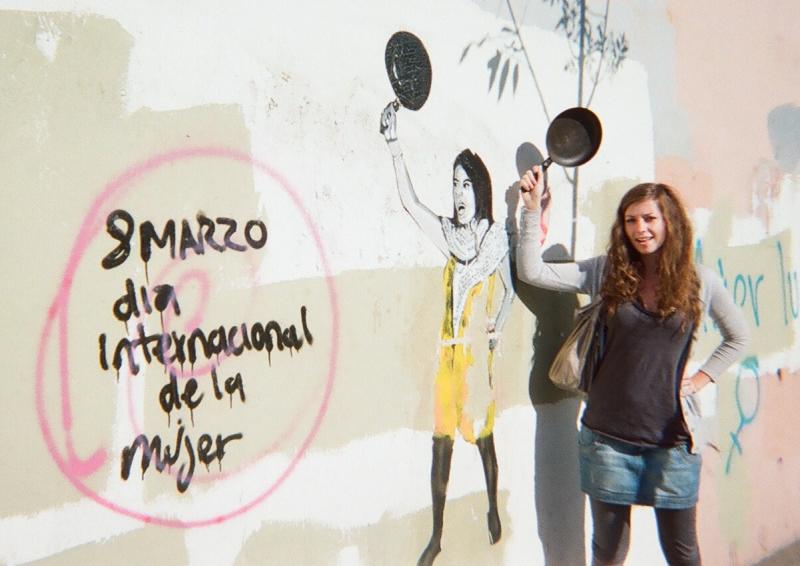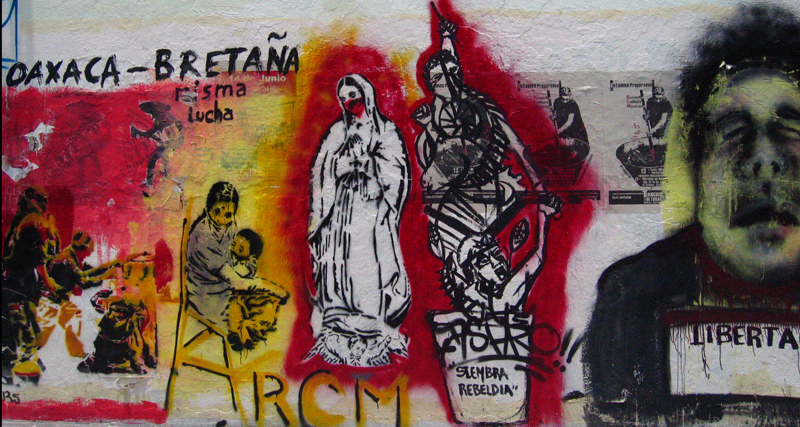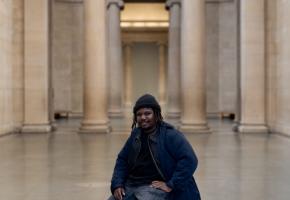A walk through the cobbled streets of this beautiful colonial city is an encounter with countless voices, sprayed over cracked and peeling layers of paint, written under stone doorways, painted across bridges.
Walls are democratic message boards: personal declarations of love scrawled next to slogans calling for proletarian revolution, complex graffiti characters sit next to simple messages informing passers by of the time and date of the next trade union meeting.
If there is one thing that unites all these voices, it is a spirit of resistance and rebellion that is both poetic and political; the image of a clenched black fist over a red heart - ‘Todo el poder al pueblo’ (All power to the people) above, ‘Todo el amor al pueblo’ (All love to the people) below; a woman holding a frying pan in a defiant gesture to dangerous macho stereotyping, ‘¡Ni Santa Ni Puta!’ (Neither Saints Nor Whores!).
Pre-Hispanic visual traditions are still safeguarded here by a large indigenous population, a rich cultural heritage that now feeds into a new urban art culture. It is perhaps not surprising that graffiti here is so political, after all this is a country with a long tradition of socially conscious public art – the Marxist muralists of the 1930s: Riviera, Orozco and Siqueiros are considered national treasures; their murals decorate important public buildings like the National Palace and the National Museum of History.
Graffiti Art: the western art world's new darling
There has been a discernible shift towards the acceptance and appreciation of graffiti culture in Britain in recent years (Banksy’s most recent show in the Bristol Museum had a solid six hour queue for its entire three month duration; a recent Pop Art exhibition at the Tate gave graffiti legitimacy by connecting it with the development of artists like Warhol and Basquiat). However what is rarely discussed in all this media attention are the politics of graffiti, or more specifically its function as a political intervention in times of social turmoil, its potency as a form of visual resistance.
Modern history is full of examples: writing on the Berlin Wall, Republican murals in Northern Ireland, situationist slogans in Paris during May ’68... As with protest songs in folk music, graffiti occurs spontaneously as a cultural response to subjugation and tyranny.
But just as 60’s protest music is redeployed in car advertisements, street culture too is easily emptied of social content and appropriated for commercial capital; graffiti style lettering lends ‘urban cool’ to any commodity from the album cover of a manufactured pop band to a particular brand of strawberry yoghurt. Indeed, no form of art is capable of resisting recuperation and being absorbed by commodity culture.

Keeping it real in Oaxaca
Yet in Oaxaca, graffiti still seems to have retained its oppositional power. The city’s inhabitants witnessed an explosion of street art in 2006, when an annual teachers strike was brutally suppressed by state police resulting in the deaths of at least 17 people, including Indymedia journalist Brad Will.
In reaction a broad based social movement was formed, APPO (Popular Assembly of the Peoples of Oaxaca), which demanded the resignation of the state governor, Ulises Ruiz Ortiz, amongst other wide reaching social reforms. It was accompanied by a fierce graffiti campaign which almost saturated the city. The visual impact was compelling; every inch of available space was targeted – messages were often impulsive and hastily sprayed, signalling a giddy optimism: ‘¡Abre los ojos! Oaxaca ya despertó’ (Open your eyes! Oaxaca has awoken). Stencils depicted the governor dressed up in fascist uniform, or as a pig, rat or dog.
Despite international condemnation of the deaths, a long march to Mexico City and a hunger strike, the structures of power held firm and, supported by the President, Felipe Calderon and 3,500 Federal Police, Ulises stayed in power. Although graffiti alone did not manage to topple a repressive and corrupt governor – it did establish an atmosphere of solidarity and support that helped sustain the opposition’s resolve for seven long months of conflict.
Because graffiti operates within a public space, it lends itself to open, direct democratic speech. This kind of graffiti is inherently anarchic in nature, showing contempt for established notions of public and private property. It is also an invaluable tool for campaigns that do not have traditional access to mainstream media. It is not so easy to give voice to a political critique if you have been born with indigenous features and darker skin in this ‘mestizo nation’; a can of paint, like a wooden box in Hyde Park corner, is the ability to stand up and speak publically; an image or message on a wall enters the public domain instantly; everyone walks down the same streets and so it transcends the social strata. Stencils provide another effective way to compete with the ideologically charged images we encounter every day; easy to achieve, they are high contrast and high impact.

Using paint where skin colour costs you
The profusion of graffiti in Oaxaca can be viewed as a reflection of its unresolved political problems; a convulsion of passion and emotion that spills out onto the streets. It can also be understood as a reflection of a more engaged and politicised culture, a sign that on all levels people are taking an active interest in the socio-economic systems in which their lives are lived. After all, video footage of the crisis revealed not only adolescents armed with spray cans but grown men and women too.
Certainly, this country still has deep, serious political problems, yet this has not seemed to defeat them – most Mexicans still believe things can change; they still care about the future And this is why the graffiti here gives me hope. Having arrived here after experiencing a depoliticised and apathetic university life in England, it is inspiring to see, literally, the signs of a people resisting ‘the way things are’.
From the beautifully noisy walls of Oaxaca we could take something home; the possibility for rejuvenating our own depressing political situation through politically charged democratic street art. Our grey streets could be injected with colour and ideas – words and images to wake people out of a catatonic state of political complacency. Paint is cheap , and ideas cost nothing. Make a wall speak.

















